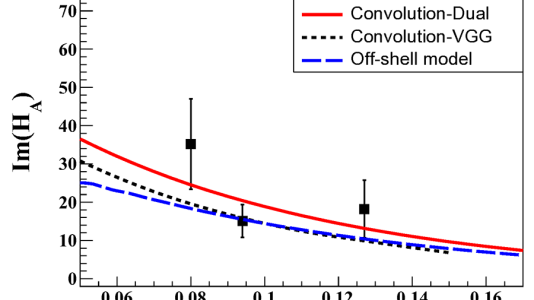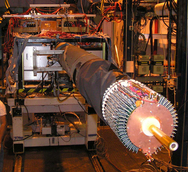
Scientific achievement
For the first time, researchers exclusively measured the beam-spin asymmetry of coherent deeply virtual Compton scattering (DVCS) off the 4He nucleus. This allowed the first extraction of a nuclear generalized parton distribution (GPD) and the first model-independent extraction of a GPD of any kind; GPDs contain tomographic information about the momenta and spatial degrees of freedom of the quarks and gluons inside the nucleus.
Significance and impact
Such a study of the 3-D structure of the 4He nucleus shows the feasibility of the approach taken and may be seen as the first step toward accessing the 3-D partonic structures of nuclei, a major quest in modern nuclear physics.
Research details
- Researchers built a radial time projection chamber calibrated specifically to detect recoiling 4He nuclei to ensure the exclusivity of the measurement.
- To identify coherent DVCS, researchers selected events containing one electron, one recoiling 4He nucleus, and at least one photon in the final state.
This research was conducted at the U.S. Department of Energy’s (DOE) Thomas Jefferson National Accelerator Facility. The work was funded by DOE’s Office of Nuclear Physics, along with several other research institutions worldwide. They include the Chilean Comisión Nacional de Investigación Científica y Tecnológica, the Italian Instituto Nazionale di Fisica Nucleare, the French Centre National de la Recherche Scientifique, the French Commissariat ‘a l’Energie Atomique, the United Kingdom Science and Technology Facilities Council, the Scottish Universities Physics Alliance (SUPA), the National Research Foundation of Korea, the Office of Research and Economic Development at Mississippi State University and the Consulat G´en´eral de France ‘a J´erusalem.
M. Hattawy et al. (CLAS Collaboration), Phys. Rev. Lett. 119, 202004 (2017). DOI: https://doi.org/10.1103/PhysRevLett.119.202004
Argonne National Laboratory seeks solutions to pressing national problems in science and technology. The nation’s first national laboratory, Argonne conducts leading-edge basic and applied scientific research in virtually every scientific discipline. Argonne researchers work closely with researchers from hundreds of companies, universities, and federal, state and municipal agencies to help them solve their specific problems, advance America’s scientific leadership and prepare the nation for a better future. With employees from more than 60 nations, Argonne is managed by UChicago Argonne, LLC for the U.S. Department of Energy’s Office of Science.
The U.S. Department of Energy’s Office of Science is the single largest supporter of basic research in the physical sciences in the United States and is working to address some of the most pressing challenges of our time. For more information, visit https://energy.gov/science.
